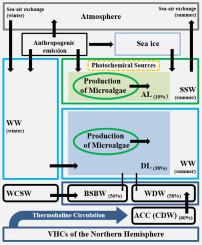Science of the Total Environment ( IF 9.8 ) Pub Date : 2020-12-04 , DOI: 10.1016/j.scitotenv.2020.143947 Cheng-Xuan Li , Kan Chen , Xia Sun , Bao-Dong Wang , Gui-Peng Yang , Yan Li , Lu Liu

|
We studied the spatial variations of six volatile halocarbons (VHCs), namely, iodomethane (CH3I), chloroform (CHCl3), tetrachloroethylene (C2Cl4), bromodichloromethane (CHBrCl2), dibromomethane (CH2Br2), and carbon tetrachloride (CCl4), and the environmental influencing factors involved in the cycling of VHCs in the upper ocean (0-500 m) off the Northern Antarctic Peninsula (NAP) during the summer of 2018. About 5%-10% of the total biogenic VHCs in the upper ocean were accumulated in the assemblage layer (AL) with high chlorophyll a. However, higher VHCs levels were observed in the dicothermal layer (DL) compared with the AL because of the preservation from winter and production from dinoflagellates and chlorophytes. Owing to the co-existence occurrence of sharp seasonal pycnocline and thick permanent pycnocline, DL could be an important VHCs reservoir in the upper water column during summer. In response to melting of sea ice and glacier, decreased salinity was responsible for ca. 50 % of the variation in the CH2Br2 and CCl4 concentrations, which corresponded with increased CH2Br2 and CCl4 concentrations in the less saline water mass. Anthropogenic CCl4 was found with an average concentration of 44.9 pmol/L, and there was a strong positive relationship between CCl4 and CHCl3 in the upper water, indicating their similar source of pollutant transport caused by anthropogenic activities. Calculated sea-to-air fluxes of CCl4, C2Cl4, CHBrCl2, and CH2Br2 averaged 478.7, 93.7, 33.7, and 61.8 nmol/(m2·d) in summer, respectively, indicating that the waters off the NAP are important sources of VHCs for the atmosphere and exert potentially adverse impacts on the Antarctica ozone depletion.
中文翻译:

夏季,南极半岛北部外海的挥发性卤代烃的发生,分布和海气通量
我们研究了六种挥发性卤代烃(VHC)的空间变化,即碘代甲烷(CH 3 I),氯仿(CHCl 3),四氯乙烯(C 2 Cl 4),溴代二氯甲烷(CHBrCl 2),二溴甲烷(CH 2 Br 2),和四氯化碳(CCl 4),以及在2018年夏季,南极半岛北部(NAP)上层海洋(0-500 m)中的VHC循环所涉及的环境影响因素。约占5%-10%上层海洋中的全部生物VHC积累在叶绿素a较高的组合层(AL)中。但是,与冬季相比,在双热层(DL)中观察到的VHCs含量较高,这是因为冬季可以保存,并且鞭毛藻和绿藻类也可以生产。由于尖锐的季节性比索克林和浓厚的永久比克林并存,因此,DL可能是夏季上水柱中重要的VHCs储层。响应于海冰和冰川的融化,盐度降低是造成钙含量升高的原因。在CH变化的50%的2溴2和CCl 4浓度,其具有增加的CH相当于2溴2和CCl 4种浓度的较少盐水质量。人为CCl 4水中的平均浓度为44.9 pmol / L,并且在上层水中CCl 4和CHCl 3之间存在很强的正相关关系,表明它们是由人为活动引起的污染物运输的相似来源。CCl 4,C 2 Cl 4,CHBrCl 2和CH 2 Br 2的海空通量在夏季分别为478.7、93.7、33.7和61.8 nmol /(m 2 ·d),表明水域NAP以外的气体是大气中VHC的重要来源,并对南极洲的臭氧消耗产生潜在的不利影响。



























 京公网安备 11010802027423号
京公网安备 11010802027423号